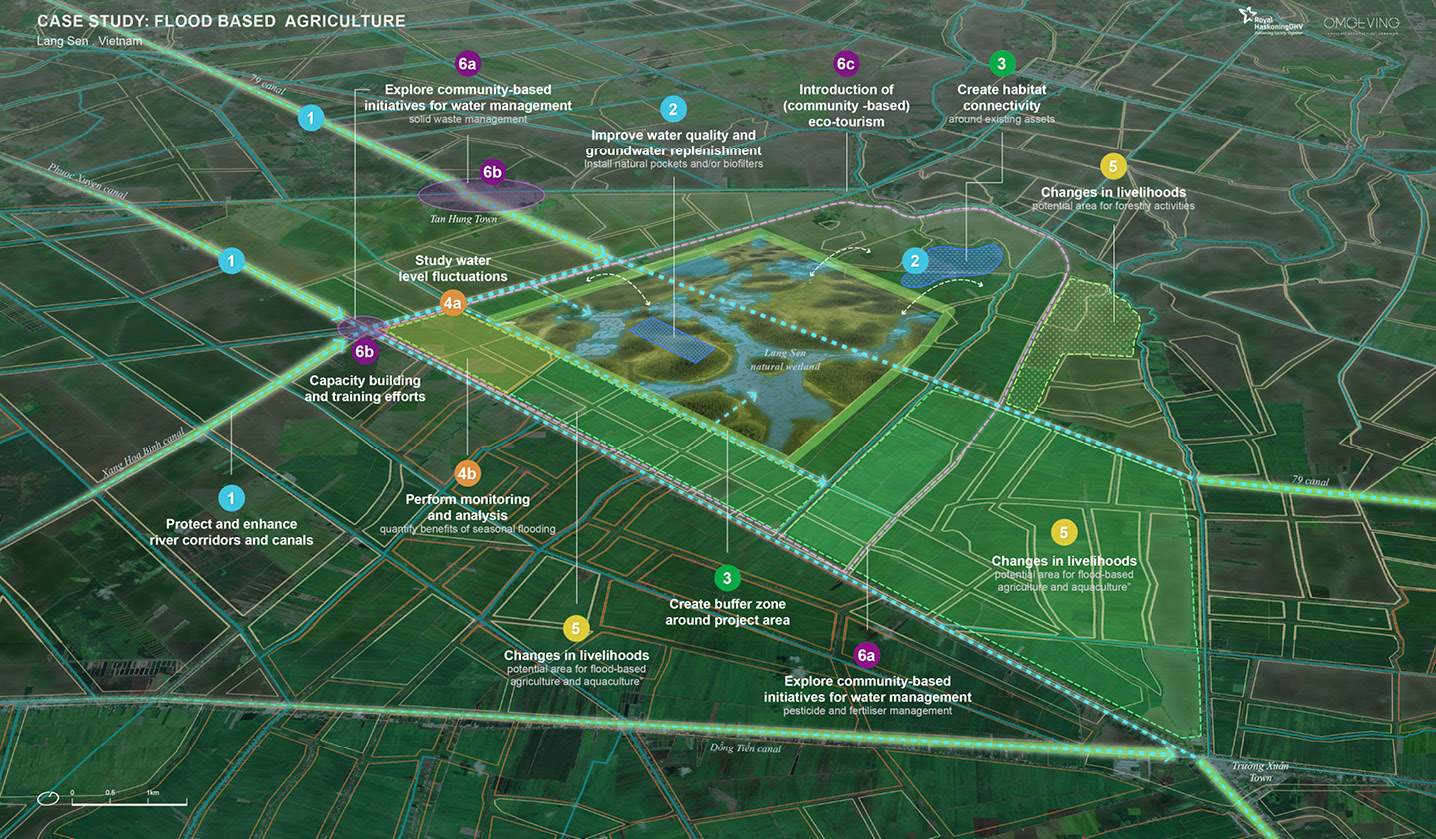Context
The Upper Vietnamese Mekong Delta comprises an extensive river, floodplain and canal network with seasonal movement of water in the floodplain. The area has undergone rapid changes in river flow regimes due to various factors, including the conversion of natural landscapes into agricultural and aquaculture facilities, urbanization, upstream development of hydropower dams, and the influence of climate change. These changes have had significant impacts on the overall function of the floodplain and the responses of wetland ecosystems. As a result, the main problems faced are the deterioration of soil quality and texture and reduced elevation of floodplains, caused by the disconnection of floodplains in an agricultural region, because of the development of dike systems. NbS that could address these problems are to rehabilitate, restore, and enhance natural floodplain dynamics and to implement flood-based agriculture. River mainstreams can re-establish connections with the floodplain, which in turn revitalizes the floodplain's role. This helps improve soil quality by depositing essential fertile sediments, increases and maintains the elevation of the floodplain and, at the same time, reduces the risk of floods in the agricultural area and potentially downstream, by storing water in the flooding season and releasing it slowly. Flood-based adaptation of agriculture can provide a sustainable alternative to intensive farming, such as triple-crop rice.
The case study location for the proposed NbS is the area surrounding Lang Sen Wetland Reserve, see Figure below. The total area is about 21,000 ha of which the Wetland Reserve covers 3,200 ha and the remaining area is mostly used for agriculture and aquaculture. Two villages are located in the area, and people live along the canals and levees. The case study area could be reconnected to main rivers through existing canals, and culverts can be installed in existing dikes to allow an area to periodically flood. As this is a large area, it could be redeveloped for flood-based agriculture in phases. For the financial analysis, it is assumed that initially, 500 ha will transition to flood-based agriculture.
On a larger scale, improving natural floodplain dynamics and flood-based agriculture could be established in areas that are suitable for the technical feasibility analysis. The highly feasible area for Group 2 (rice with fish stocking) in the Mekong Delta in Vietnam is 2,947.26 km2 or 294,726 ha (see Table below). For the financial analysis, it is assumed that 25% of this area will transition to flood-based agriculture. This would be a total of 73,681 ha. For Cambodia, 25% of the highly suitable area for Group 2 would be a total of 29,947 ha. Hence, the total area of a basin-wide project would be 103,628 ha. The other groups are not considered as they have lower revenues or because of lacking data.
Table. Suitability statistics per group for Vietnam and Cambodia (km2)
Country | Group | Not suitable | High suitable | Moderate | Marginally |
Vietnam | Group 1 | 8,590.11 | 2,998.69 | 3,853.26 | 5,295.85 |
Vietnam | Group 2 | 8,590.11 | 2,947.26 | 3,904.69 | 5,295.85 |
Vietnam | Group 3 | 5,712.91 | 3,679.03 | 3,459.34 | 7,886.63 |
Vietnam | Group 4 | 13,578.53 | 1,682.91 | 3,024.62 | 2,451.85 |
Cambodia | Group 1 | 35,131.24 | 408.51 | 7,655.49 | 1,754.93 |
Cambodia | Group 2 | 35,131.24 | 1,197.88 | 6,866.11 | 1,754.93 |
Cambodia | Group 3 | 33,360.13 | 528.08 | 4,825.27 | 6,236.68 |
Cambodia | Group 4 | 7,439.70 | 5,707.33 | 0.12 | 31,803.01 |
Note: Group 1 is rice/upland crop + (giant) freshwater prawn, Group 2 is rice/upland crop + fish stocking, Group 3 is rice + lotus or lotus with fish, Group 4 is Melaleuca timber plantations
Improving natural floodplain dynamics with flood-based agriculture would involve many stakeholders, including a large number of government agencies. These stakeholders can be categorised into the following main groups:
Stakeholder group | Involvement |
Farmers / households / farming cooperatives | Direct beneficiaries of the project, are expected to change their farming model |
Private sector companies | Potential beneficiaries of the project, adjusting to new or different business opportunities |
Government organisations | Design, implementation and support of the projects |
Funders | Provide loans, funds and other forms of financing for the project |
Society | At a larger scale, social, economic and environmental co-benefits will affect society |
In addition to these stakeholders, others can be identified, such as NGOs, knowledge institutions and contractors. However, these are not expected to be the main beneficiaries or responsible for the costs of the project and hence are not included in the financial and economic analysis. Note that there could be some overlap in stakeholder groups, e.g., government organisations could also be funders.
